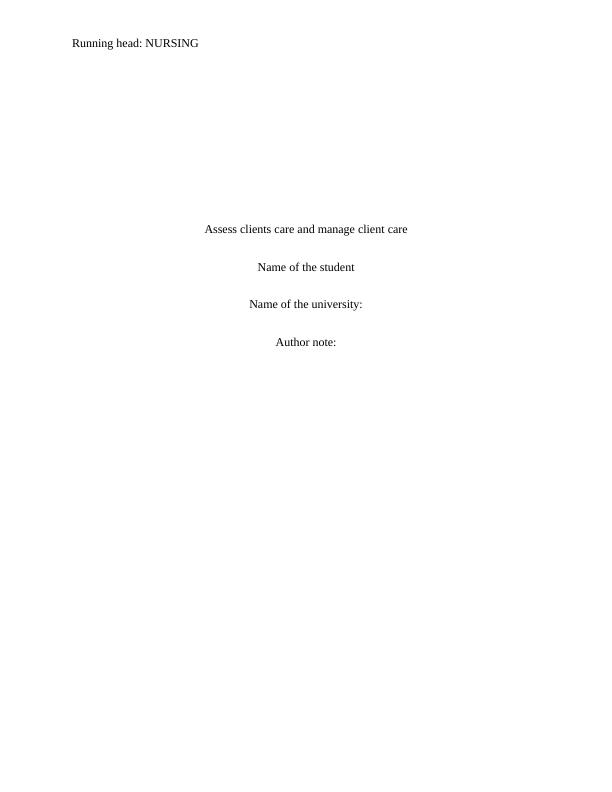Ask a question from expert
Assess Clients Care and Manage Client Care
6 Pages1581 Words337 Views
Added on 2020-04-21
Assess Clients Care and Manage Client Care
Added on 2020-04-21
BookmarkShareRelated Documents
Running head: NURSINGAssess clients care and manage client careName of the studentName of the university:Author note:

1NURSINGPART 1: Nursing AssessmentCNSIn this part the level of consciousness is measured of Ms. Azizi, as thepatient is having dyspnoea which is a clinical sign of hypoxia (Hayden etal., 2015).CVSAccording to the case study, the vital signs include blood pressure and heartrate. Next the general inspection was done about the appearance of Ms.Azizi and the way she responds to activity. As per the case study, Ms.Azizihas a past medical history of hypertension; hence it is important to assessthe blood pressure and the heart rate (Sørensen et al., 2013).RespiratoryThis case study is mainly concentrating on the Respiratory rate, O2saturation and chest auscultation that would be necessary for Ms. Azizi asshe is suffering from short of breath and has cough due to Pneumonia(Chavez et al., 2014). GIT & metabolicThis assessment is done mainly for abdominal pain and asked Ms. Aziziabout the history of abdominal health because she was complaining aboutnausea, stomach cramps and loose bowels for overnight. (Musher &Thorner, 2014). RenalThis assessment studies the elimination of fluid and inspection of urinarypattern, also the fluid balance chart. As Ms. Azizi mentions about havingloose bowel overnight, it might indicate Ms. Azizi’s fluid balance status.The kidneys used to maintain a responsive balance in the excretion andretention of the fluids. If the concentration of the fluids and the electrolytesolutes are in a state of equilibrium, than the increase in the intake of thefluid results in the increase of the production of udine.(Almirall et al.,2015). SkinThis assessment deals with the inspection of skin, determining the colour,moisture, temperature, Oedema and texture. Assessment of skin can reveal avariety of skin conditions, including changes in oxygenation, circulation,nutrition, local tissue damage and hydration (Huijskens et al. 2013).Psychological &dischargeThis assessment concentrating on indirectly interview Ms. Azizi by findingout about her lifestyle, culture, education background, values, beliefs andprevious experiences to gather the information and how she emotionallyresponses on the illness and treatments. A great deal can be learned aboutmental capacities and emotional state by simply interacting with Ms. Azizi.Throughout the nursing care activities this will be the keys to gatherinformation about the way she behaves and thinks, and the appropriatenessof emotions and idea (Torres et al., 2013).PART 2: Nursing Complications/Problems

2NURSING1.Acute pain identified with aggravation of the lung parenchyma. The patient describedthat she was suffering from chest pain, looked frowning and checks vital signs: delayedheartbeat (tachycardia). 2.Ineffective breathing symptoms identified with excessive emission optional to disease. Itwas being described by the patient that she was sick of trouble in breathing, checks keysigns: increase in breathes (Lang et al. 2014). 3.Imbalanced Nutrition: not as much as body necessities identified with diminished hunger,optional to sickness and spewing, portrayed by the patient griped of queasiness, loss ofcraving and retching. 4.Activity narrow mindedness identified with lopsidedness amongst supply and oxygenrequest. Described by the patient grumbled of shortcoming, trouble breathing, lookingfrail, shortness of breath, checks essential signs: breath increments.PART 3: Nursing Implementation and Evaluation(A)Care planNursing complication(Actual and Potential problems)InterventionsRationaleEvaluation1.Disturbedsleeping patternRT PneumoniaAEB productivecough To give pt. semi- fowler’sposition as comfortable aspossible.Instruct relaxation exercisebefore bed and increasedaytime physical activities Semi-Fowler’s positionwill facilitate thecirculation of O2 andCO2.To reduce stress andpromote sleep.Patient’s willachieveoptimumamount ofsleep duringhospitalization2.HyperthermiaRT PneumoniaEncourage and offer oralfluid intake every 2 hourlyTo prevent patient fromdehydrationPatient willdemonstrate

End of preview
Want to access all the pages? Upload your documents or become a member.
Related Documents
Nursing Management of the Patient with a Complex Condition Assessment 2022lg...
|9
|3003
|23
Case Study Analysis for Nursing Interventions and Patient Carelg...
|23
|6126
|279
HLTEN606B - Assess clients and managelg...
|11
|2828
|141
Assignment On Nursing Care Plan.lg...
|8
|1255
|12
The Common Causes of Acute Pancreatitislg...
|5
|871
|17
NRSG370 – Clinical Integration - Specialty Practicelg...
|10
|3041
|16